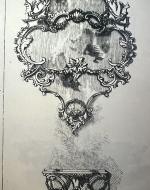Created by Samantha Rizk on Tue, 02/18/2025 - 09:52
Description:
The Great Exhibition of 1851 in London was the world’s first international fair! It displayed Britain’s technological advancements, among many other luxurious items from other countries. Mirrors were a lavish item in the Victorian era, and this booth showcases several unique mirrors. The first image is a mantle-piece, ornamented with mirrors. The second set of images shows features of a pearl-handled mirror in a dressing-case. The third image shows a hanging mirror with a bracket table. All three mirrors have different functions, uses, and varying levels of detail.
Mirrors at the Great Exhibition, booth created by Samantha Rizk, April 2025. The physical booth was made in Skidmore College’s Idealab by using a 3D laser printer. The image in the background is a photocopy of a hand-colored lithograph, created in 1851 by Walter Goodall. It functions as part of my background for my physical wooden booth. Its title is Indian Court, and it displays some items from India that were being sold at the Great Exhibition. I decided to use this image because it provides an authentic scene which helped greatly when building my booth, as I made my booth the size of this image. After the background was glued onto the physical box, I printed out images of my mirrors. I then rearranged them in the background. I did this to help highlight my narrative arc, which includes the practicality and elegance of several Victorian mirrors. When adding the final touches to my box, I added Victorian customers on the sides and wallpaper to include an elegant touch.
"A Mantle-Piece, Ornamented with Mirrors," 1851, Pierre Nicolas Luce, in The Official Descriptive and Illustrated Catalogue of the Great Exhibition of the Works of Industry of all Nations, “France and Algiers” (volume 3), p. 1240, Plate 245. This piece was created by Pierre Nicholas Luce in Versailles, France. The quicksilvered mirror that was ornamented in this chimney mantlepiece serves two unique purposes. It can bear “intense heat without cracking” and “reflect the heat in the interior of an apartment in the same manner that they reflect light” (1240). The quicksilvered mirror not only functions properly within the mantelpiece to foster the function of the chimney but also adds an elegant touch to the piece overall. As such, it’s able to sustain a fire fueled by wood, coal, and coke. This piece highlights the multiple capabilities that Victorian mirrors possessed.
"Dressing-case" 1851, Charles Asprey, in The Official Descriptive and Illustrated Catalogue of the Great Exhibition of the Works of Industry of all Nations, Class 26, “Furniture, Upholstery, Paper Hangings, Papier Maché, and Japanned Goods” (volume 2, section 3), p. 730, and pp. 791-92. https://daniellucian.com/antiques/DL183/asprey-antique-dressing-case-from-the-great-exhibition-of-1851. This dressing-case by Charles Asprey is displayed by a collage of images. One photo (not in color) is from the 2nd volume of the Great Exhibition Catalogue. The photos in color were photographed by Daniel Lucian and are uploaded to the Antique Box Guide website, (https://www.antiquebox.org), where an original dressing-case is for sale. This dressing-case has a unique history behind it. It was made of rare wood and described as “Neptune’s attributes” (791). The pearl-handled mirror is in another compartment of the box, as a velvet layer separates it and holds it in place. This box could fit a plethora of things: from perfume bottles to ivory brushes and a pearl-mounted shoe lift. It also contains “secret compartments for sovereigns, notes, and jewelry” (791). According to the Antique Box Guide, dressing cases were initially made for upper-class men, but this shifted as upper-class women began to travel. The utility of this pearl-handled mirror was to provide women with luxury when they traveled.
"Hanging Mirror and Bracket Table" 1851, Clark, Samuel B., in The Official Descriptive and Illustrated Catalogue of the Great Exhibition of the Works of Industry of all Nations, Class 26, “Furniture, Upholstery, Paper Hangings, Papier Maché, and Japanned Goods” (volume 2, section 3), p. 747. This hanging mirror was created by Samuel B. Clark. It contains many unique features as the mirror was in an "ornamented frame, the decorations consisting of birds, flowers, and shells" (747). Beneath the mirror are two tables, one a center table and the other a work table. The center table is made from ebony, rosewood, and buhl while the work table is made of English walnut. The mirror is "represented by the annexed cut, with the bracket-table below it" (747). Truly an exquisite piece!





